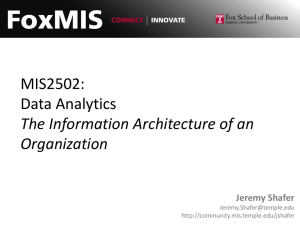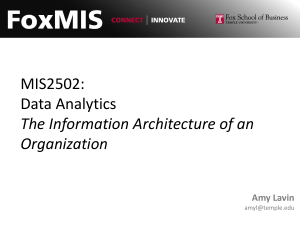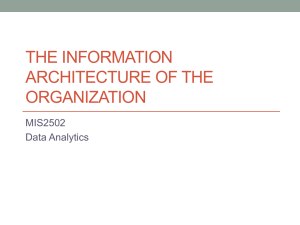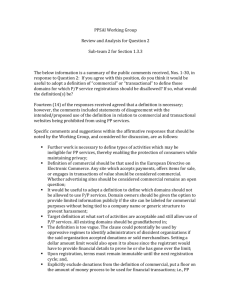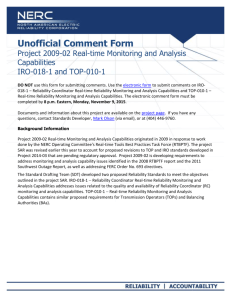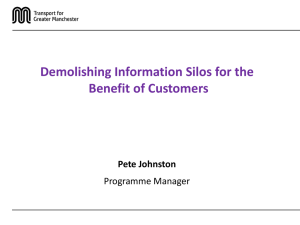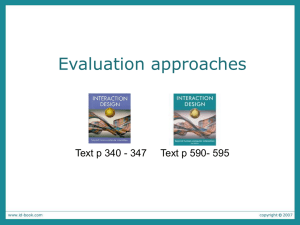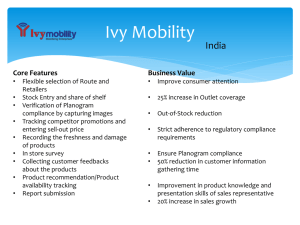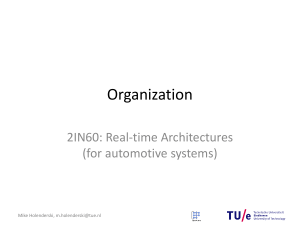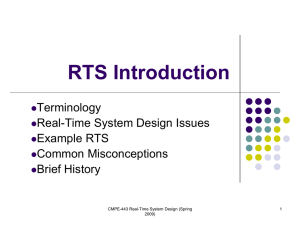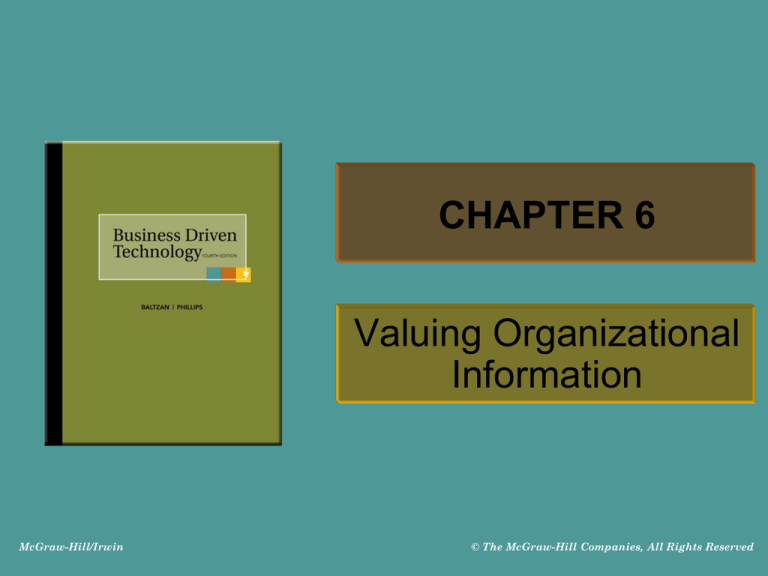
CHAPTER 6
Valuing Organizational
Information
McGraw-Hill/Irwin
© The McGraw-Hill Companies, All Rights Reserved
LEARNING OUTCOMES
6.1 Explain how information differs
throughout an organization
6.2 Assess the impact of low-quality
information on an organization and the
benefits of high-quality information on
an organization
6-2
LEARNING OUTCOMES
6.3 List, describe, and provide an example
of each of the five characteristics of
high quality information
6-3
ORGANIZATIONAL INFORMATION
• Information is everywhere in an organization
• Employees must be able to obtain and analyze the
many different levels, formats, and granularities of
organizational information to make decisions
• Information granularities refers to extent of details within
the information (fine or coarse)
• Successfully collecting, compiling, sorting, and
analyzing information can provide tremendous insight
into how an organization is performing
6-4
ORGANIZATIONAL INFORMATION
• Levels, formats, and granularities of
organizational information
6-5
THE VALUE OF TRANSACTIONAL
AND ANALYTICAL INFORMATION
• Transactional information verses analytical
information
6-6
Transactional information
Transactional information encompasses
all of the information contained within a
single business process or unit of work, and
its primary purpose is to support the
performing of daily operational tasks.
Examples of transactional information are
withdrawing cash from an ATM, making an
airline reservation, or purchasing stocks
6-7
Analytical Information
Analytical Information encompasses all
organizational information, and its primary
purpose is to support the performing of
managerial analysis tasks. Analytical information
includes transactional information along with other
information such as market and industry
information. Examples of analytical information
are trends, sales, product statistics, and future
growth projections.
6-8
THE VALUE OF TIMELY
INFORMATION
• Timeliness is an aspect of information that
depends on the situation
– Daily monitoring of flight delays.
– Weekly sales forecasts.
– Annual reviews of production facility capacities
• Real-time information – immediate, upto-date information
• Real-time system – provides real-time
information in response to query requests
6-9
Real-Time Info.
• Questions:
• Is credit card transaction a real-time one?
• Is bank card transaction a real-time one?
• Timeliness is relative and should be to the point
for correct and efficient decision making.
• Real-time info has its own pitfalls. It may not
speed up decision making.
6-10
THE VALUE OF QUALITY
INFORMATION
• Business decisions are only as good as
the quality of the information used to
make the decisions
– Garbage In Garbage Out
• You never want to find yourself using
technology to help you make a bad
decision faster
– The automation of a useless system leads to
a faster, state-of-the-art … useless system. 6-11
THE VALUE OF QUALITY
INFORMATION
• Characteristics of high-quality information
include:
6-12
THE VALUE OF QUALITY
INFORMATION
• Low quality information example
6-13
Understanding the Costs of
Poor Information
• The four primary sources of low quality
information include:
1. Online customers intentionally enter inaccurate
information to protect their privacy
2. Information from different systems have
different entry standards and formats (e.g.
date)
3. Call center operators enter abbreviated or
erroneous information by accident or to save
time
4. Third party and external information contains
6-14
inconsistencies, inaccuracies, and errors
Understanding the Costs of
Poor Information
• Potential business effects resulting from
low quality information include:
– Inability to accurately track customers
– Difficulty identifying valuable customers
– Inability to identify selling opportunities
– Marketing to nonexistent customers
– Difficulty tracking revenue due to inaccurate
invoices
– Inability to build strong customer relationships
6-15
Understanding the Benefits of
Good Information
• High quality information can significantly
improve the chances of making a good
decision
• Good decisions can directly impact an
organization's bottom line
6-16



